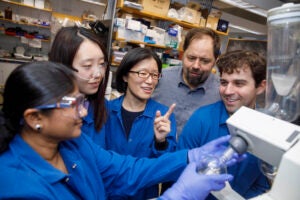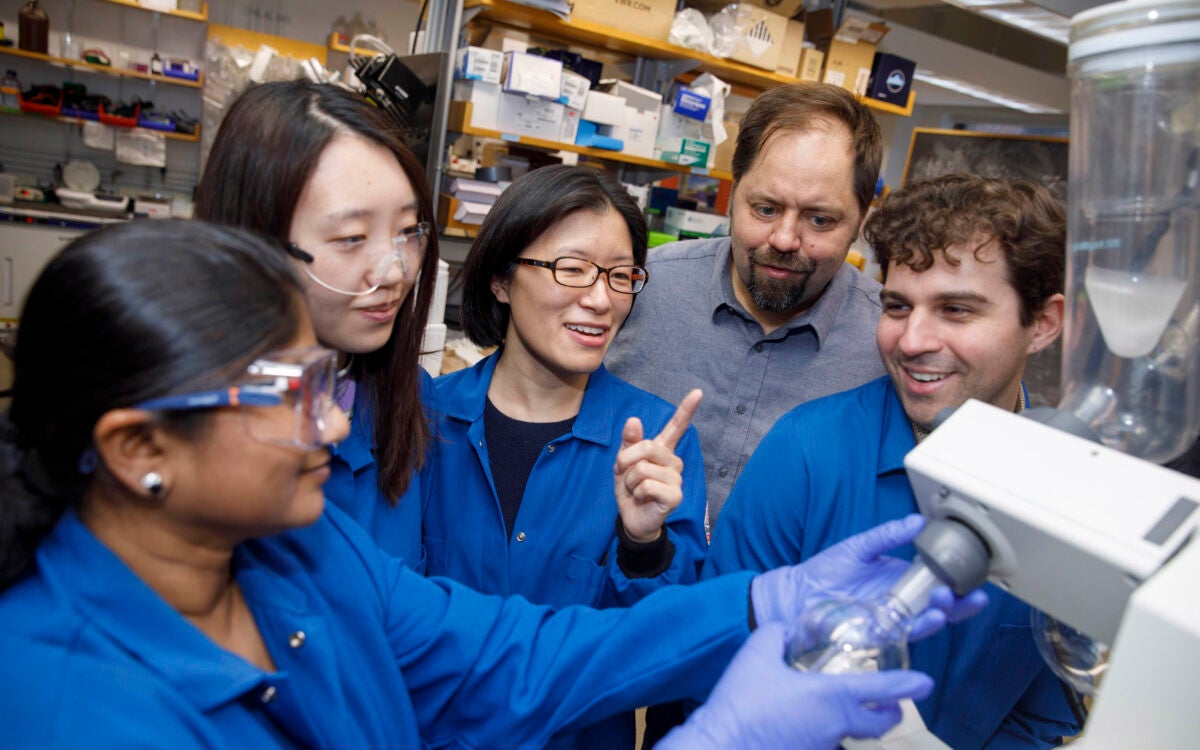Eating meat led to smaller stomachs, bigger brains
Scholar revisits her theory explaining evolution of early primates into humans
Behind glass cases, Harvard’s Peabody Museum of Archaeology displays ancient tools, weapons, clothing, and art — enough to jar you back into the past.
But the venerable museum offered a jarring moment of another sort in its Geological Lecture Hall last month (March 20). Paleoanthropologist Leslie Aiello delivered a late-afternoon talk on diet, energy, and evolution. It was jolting to see her, slight and matronly, stand before a story-high screen filled with images of rugged early hominids on a savannah, gathered around fallen game.
Then again, Aiello — as one of her admirers put it — is the “alpha female” among anthropologists who make a study of human origins. She co-wrote the widely used text “An Introduction to Human Evolutionary Anatomy” (Academic Press, 1990), based on the idea that the fossil record offers clues to how early hominids looked, moved, and even ate.
Aiello — a professor for three decades at University College, London, and now president of the Manhattan-based Wenner-Gren Foundation for Anthropological Research — was in Cambridge to deliver the 2008 George Peabody Founder’s Lecture.
Introducing Aiello was Daniel E. Lieberman, a professor of biological anthropology at Harvard and a proponent of the idea that upright walking and long-distance endurance running set early humans on their novel evolutionary path.
He held up a well-thumbed copy of Aiello’s book and said, “Her CV is so long, it’s hard to know where to start.” But two seminal ideas stand out, said Lieberman. One is that in evolutionary terms, big human brains — with enormous energy requirements — are inversely proportional to gut size.
This idea — called the Expensive Tissue Hypothesis (ETH) in Aiello’s co-authored 1992 paper — argues that around 1.5 million years ago early humans began to eat more meat, a compact, high-energy source of calories that does not require a large intestinal system.
A second seminal idea posited by Aiello and another colleague is that increased brain size meant higher reproductive costs for females — who, over time, compensated in part by increasing in size at a greater rate than males of the genus Homo. (Homo erectus females had a 64 percent larger body mass than earlier hominids; males of the species — though still larger than females — were larger than their earlier male counterparts by only 45 percent.)
In her lecture, Aiello revisited ETH to see how scientifically robust an idea it was after more than 15 years of academic scrutiny.
The idea is still viable, she said, but in an era of better testing technology and accelerating scholarship on human origins, ETH has theoretical competitors explaining the evolution of bigger brain size.
For one, some scientists say that walking upright — “bipedalism” — is the most important way to support larger brain size. (Upright hunters and gatherers were more efficient than their quadripedal counterparts.) Others say that the key to supporting big brains is the smaller muscle mass of hominids compared to apes.
And still other scientists have pointed out that ETH doesn’t hold true for all animals, including birds and bats.
Said the modest Aiello, “we’re much further along in understanding energy tradeoffs and evolution than 15 years ago.”
But for whatever reason, she said, “encephalization” — the tendency of some species to evolve larger brains — is the third stage that led humans to civilization. (One earlier stage is bipedalism. The oldest is “terrestriality,” the movement of early hominids from canopied forests — rich in lower-calorie foods — to savannahs, where small game, carrion, and insects supplemented a plant-based diet.)
Around 1.5 million years ago there was “a lot going on” in evolutionary terms, said Aiello. Hominid habitat changed, along with the size of early human craniums (larger) and jaws (smaller).
But growing brain size presented a metabolic problem. A gram of brain tissue takes 20 times more energy to grow and maintain than a gram of tissue from the kidney, heart, or liver, she said. Gut tissue is metabolically expensive too — so as brains grew gut sizes shrank.
It’s likely that meat eating “made it possible for humans to evolve a larger brain size,” said Aiello. Early human ancestors probably consumed more animal foods — termites and small mammals – than the 2 percent of carnivorous caloric intake associated with chimpanzees.
The social implications of increased meat eating were interesting, said Aiellio. In most primates, there’s no food sharing between females and offspring, she said. But the difficulty of getting meat led to cooperative food sharing among early humans, strengthening the bond between a female and her offspring.
Increased meat eating also likely led to an increased division of labor between the sexes, said Aiello. The males would hunt and provide; the females — faced with more intensive motherhoods — would raise the hominid young, who were dependent longer than ape infants.
But is there evidence in the fossil record for a transition to what Aiello called “a high-quality animal-based diet”?
Briefly, yes. For one, animal bones from 2.5 million years ago showed cut marks thought to be from the earliest stone tools. And earlier species of early hominids had strong jaws and molar-like teeth; later species were more like modern humans, with weaker jaws, smaller faces, and smaller teeth.
There are other of bits of evidence pointing to meat eating by early humans, said Aiello. “My favorite are the tapeworms.”
Parasite historians — yes, there are some — say that hyenas and early humans were infected by the same type of tapeworms, which suggests they shared booty from scavenged carrion. (Such analysis is possible because of “isotopic ecology,” the study of microscopic traces of food-related isotopes in both fossils and living creatures.)
Our human ancestors were not wholly carnivores — “that would be silly,” said Aiello, who does not argue that meat-eating caused bigger brains — just that it made bigger brains possible.
About 1.5 million years ago, she said, “there was a definite dietary change to foods of high nutritional value [that were] easy to digest.”
Better food sources and the social changes they engendered accelerated our human ancestors toward civilization. “Whatever was happening here,” said Aiello of the highest branch in the primate tree, “Homo erectus got it right.”




